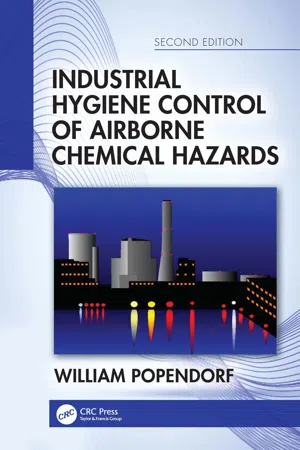
Industrial Hygiene Control of Airborne Chemical Hazards, Second Edition
- 696 pages
- English
- ePUB (mobile friendly)
- Available on iOS & Android
Industrial Hygiene Control of Airborne Chemical Hazards, Second Edition
About This Book
Are you a practicing occupational hygienist wondering how to find a substitute organic solvent that is safer to use than the hazardous one your company is using? Chapter 6 is your resource. Are you a new hygienist looking for an alternative technology as a nonventilation substitute for an existing hazard? Chapter 8 is your resource. Are you looking for an overview of ventilation? Chapters 10 and 11 are your resource? Are you an industrial hygiene student wanting to learn about local exhaust ventilation? Chapters 13 through 16 are your resource. Are you needing to learn about personal protective equipment and respirators? Chapters 21 and 22 are your resources. This new edition brings all of these topics and more right up-to-date with new material in each chapter, including new governmental regulations.
While many of the controls of airborne hazards have their origins in engineering, this author has been diligent in explaining concepts, writing equations in understandable terms, and covering the topics of non-ventilation controls, both local exhaust and general ventilation, and receiver controls at the level needed by most IHs without getting too advanced. Taken as a whole, this book provides a unique, comprehensive tool to learn the challenging yet rewarding role that industrial hygiene can play in controlling airborne chemical hazards at work.
Most chapters contain a set of practice problems with the solutions available to instructors.
Features
-
Written for the novice industrial hygienist but useful to prepare for ABIH certification
-
Explains engineering concepts but requires no prior engineering background
- Includes specific learning goals that differentiate the depth of learning appropriate to each topic within the fuller information and explanations provided for each chapter
-
Contains updated governmental regulations and abundant references
-
Presents a consistent teaching philosophy and approach throughout the book
-
Deals with both ventilation and non-ventilation controls
Frequently asked questions
Information
1 An Introduction to Industrial Hygiene Chemical Hazard Control
I An Overview of Industrial Hygiene
Industrial hygiene is both the science and artdevoted to the Anticipation, Recognition, Evaluation, and Controlof those environmental factors or stressesarising in or from the workplacewhich cause sickness, impaired health, significant discomfort or inefficiencyamong workers or among citizens of the community.
- Anticipation: the prospective recognition of hazardous conditions based on chemistry, physics, engineering, and toxicology
- Recognition: both the detection and identification of hazards or their adverse effects through chemistry, physics, and epidemiology
- Evaluation: the quantitative measurement of exposure to environmental hazards and the qualitative interpretation of those hazards
- Control: conception, education, design, and implementation of beneficial interventions carried out that reduce, minimize, or eliminate hazardous conditions
- Chemical: gases, vapors, dusts, fumes, mists, solvents
- Physical: barometric pressure, temperature, noise, vibration, nonionizing, and ionizing radiation
- Biological: bacteria, fungi, parasites, and their toxins (although toxins are also chemicals)
- Ergonomic: the interaction of machine design and operational practices with our human anatomy
- Mechanical: primarily safety (injury, fatality, property damage)
- Psychological: peer pressure, job security and satisfaction, education, and motivation
Table of contents
- Cover
- HalfTitle Page
- Series Page
- Title Page
- Copyright Page
- Contents
- Preface
- Acknowledgments
- Author
- List of Abbreviations
- List of Conversion Factors
- Chapter 1 An Introduction to Industrial Hygiene Chemical Hazard Control
- Chapter 2 The Behavior of Gases and Vapors
- Chapter 3 The Behavior of Aerosols
- Chapter 4 Control Criteria for Airborne Chemicals
- Chapter 5 Vapor Generation, Behavior, and Hazards
- Chapter 6 Vapor Pressure within Mixtures
- Chapter 7 Changing the Workplace
- Chapter 8 Source Control via Substitution
- Chapter 9 Other Source and Nonventilation Pathway Controls
- Chapter 10 An Overview of Local Exhaust Ventilation
- Chapter 11 Ventilation Flow Rates and Pressures
- Chapter 12 Measuring Ventilation Flow Rates
- Chapter 13 Designing and Selecting Local Exhaust Hoods
- Chapter 14 Predicting Pressure Losses in Ventilation Systems
- Chapter 15 Exhaust Air Cleaners and Stacks
- Chapter 16 Ventilation Fans
- Chapter 17 Ventilation Operating Costs
- Chapter 18 Local Exhaust Ventilation System Management
- Chapter 19 General Ventilation and Transient Conditions
- Chapter 20 General Ventilation in Steady-State Conditions
- Chapter 21 Administrative Controls and Chemical Personal Protective Equipment
- Chapter 22 Respirator Controls
- Appendix A
- Appendix B
- Appendix C
- Index